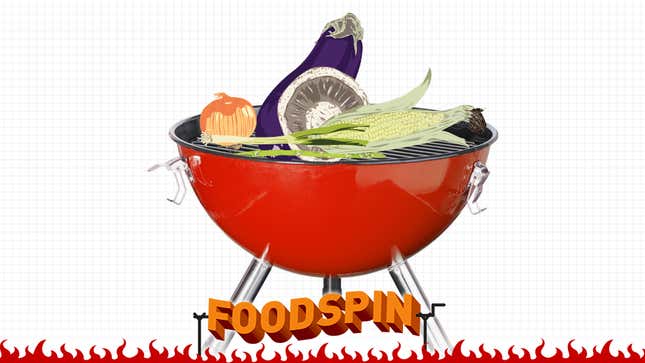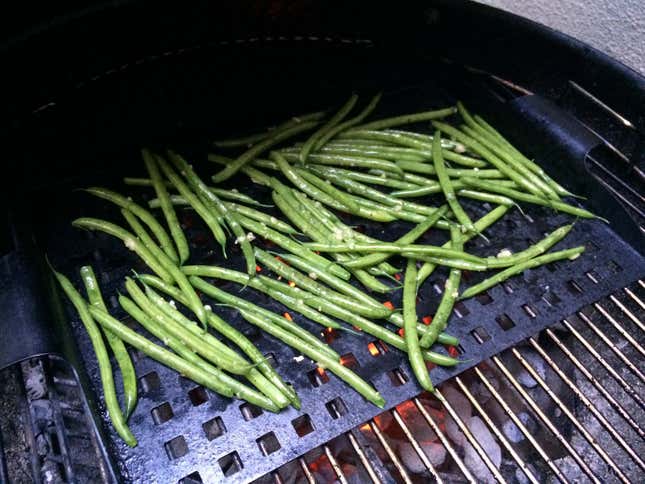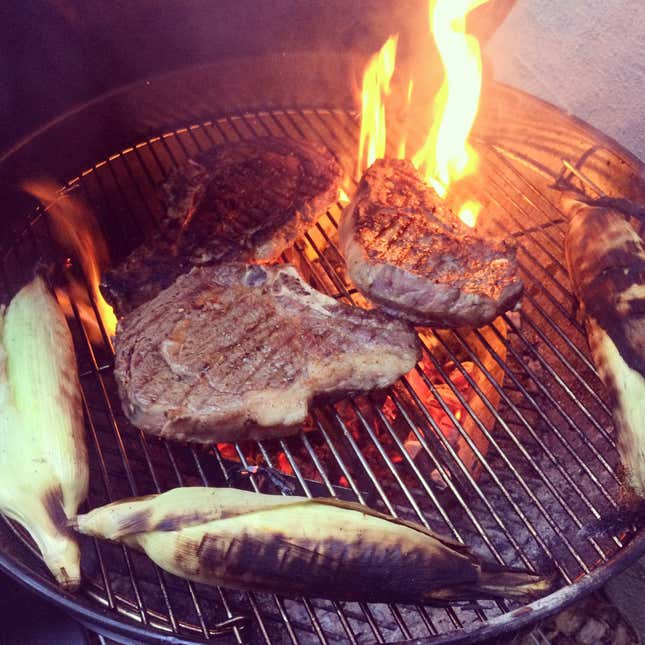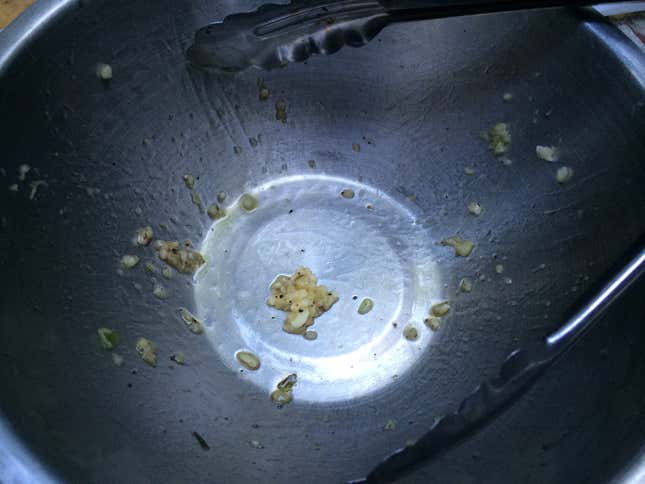
Albert Burneko is off. Your guest Foodspinner is friend of the program and Drynuary evangelist John Ore.
It's "officially" summer now, although if you're like me, you've been wearing white shoes since the Final Four. You've also probably been grilling since the thermometer hit 55 degrees more than twice in one week. The awesome thing about meat—you know, aside from the fact that it tastes like delicious meat—is that it's not terribly seasonal. Sure, sustainable grass-fed livestock and wild game have peak seasons, but you can get quality baby-back ribs in November, T-bones in February, and chicken parts when there are two feet of snow on the ground.
While most carnivores don't alter our meat intake with the seasons, those of us who still giggle when our pee smells funny welcome the sight of decent asparagus at the beginning of summer. From the farmer's market to Piggly Wiggly, the return of fresh produce often puts our bellies on alert that it's Summer and Time for Strawberries and Where the Hell Are the Heirloom Tomatoes? As seasonal vegetables rotate back into your stores and your diets, you need to make sure that they also rotate onto your grill.
Typically, unless you're a vegetarian (no judgments!), the grill brush is reserved for scouring the remnants of whatever animal part you last burned to a crisp off of the grate. But you're seriously missing out if you dedicate 100 percent of your grilling surface to meat and 100 percent of your stovetop to side dishes this summer. I'm not trying to convince you to make couscous on your Weber, but you need to be grilling all of your veggies from now until Labor Day.
For one thing, grilling vegetables is stupid easy: Fresh vegetables like asparagus, sugar peas, bell peppers, and green beans just need a little bit of olive oil, some aromatics, and a hot fire. And easy means carefree and better and less cleanup. For another, grilled vegetables taste better: Grilling enhances a meal in both real and perceived ways, from the flavor to the experience. Hell, it's a scientific fact that beer tastes better standing next to a grill with tongs in your hands and a brother-in-law micromanaging said tongs.
Look, maybe it makes for a nice paleo narrative (it doesn't), but we all know you need something else on your plate besides grilled meat. You can sit there and squander your primordial right to fire, watching precious heat slowly burn out like your potential after you've overcooked your skirt steak. Or you can take advantage of extant hot coals and grilling surface, and buy yourself some time away from the kids noodling with the fire, and make sure that everything on your plate spent time on the grill.
First things first. You're going to need something like a grill pan. Yes, it's inevitable that you'll lose a haricot vert or two to the fire—sacrifice to the Grill Gods—but there's no point in throwing sugar peas into the fire like pennies down a subway grate. A grill pan ensures asparagus spears don't slip through your grilling surface, it conducts heat nicely, and it's easy to clean. A grill basket is often better, since some have locking covers that allow you to agitate mixed vegetables like you were using a sauté pan. The point is you want to control collateral damage while still letting the raw flames lick your rabbit food.

So, rabbits, where to start?
Corn. In the husk, as God intended. Nothing else. Throw it on while the coals are hot, squeal like an eight-year-old when the silk catches on fire. A quarter turn every now and then. When the husk is a bit charred and wrinkly from steaming the corn cob inside, you're done. Shuck it while it's hot, and you've got a built-in handle. Roll it lengthwise on a stick of butter, add salt and pepper, debate on whether the right method is to eat it in rows horizontally or vertically. (The correct answer is horizontally.) You can also slice it right off of the cob and add the roasted kernels to salads and salsas.

Asparagus. Snap the woody bottom part of the stalk off at its natural breaking point by bending each stalk about two-thirds of the way down. In a large bowl or baking dish, toss with olive oil, salt, pepper, and aromatics like minced garlic or thinly sliced shallots. If you are fancy, you can infuse your oil beforehand by heating the aromatics in it on the stovetop until fragrant and translucent, and then tossing with the asparagus. Once you've got the spears good and coated, toss them on your grill pan, which has been heating over a hot charcoal fire.
IMPORTANT: Reserve the vessel you tossed them in with the residual oil and aromatics. Mess with them a bit, as this is the fun part about grilling vegetables: You get to futz with them to a level that you can't with meat, which reaches deep into the reptilian, prehistoric part of our brains that causes us to ache with anxiety if we haven't messed with whatever is on the grill for more than two minutes. You're looking for a bright green, slightly charred, pliant asparagus spear. My test for doneness relies on simply picking up a representative stalk (not too fat, not too thin!) in the middle with a pair of tongs, holding it horizontally and making it wave bye-bye. The spear should flex, and curve in a gentle arc when in its resting state. It should NOT yield completely and bend limply into an inverted U shape. You want a toothsome snap when you bite into it, not mush. Those are vitamins!
A good 10 minutes should suffice, and you can cover the grill to roast them and speed up the process in intervals. When your forest of asparagus is done, throw 'em back into your prep vessel with the residual oil and toss again. This finishes them with a slight, fresh coat of oil and flavor, and makes for a lovely presentation when your guests start digging into them with their grubby hands.

Note: This method also works well for sugar peas, sliced peppers, haricots vert, broccoli, and garlic scapes. Yeah, I know, I'd never heard of them until I stumbled across them at my local farmer's market and was intrigued by their WTF-is-this funkiness. Apparently some residual appendage of garlic bulbs, they are harvested before they steal nutrients from the garlic proper, and we get some Medusa-like tangle of grillables that will make ramp aficionados look like poseurs. Since they are quite flavorful on their own, you can ditch the aromatics and just toss with olive oil, salt, and pepper. Grill until they soften and are a bit charred, eat them by themselves or chop them up and add to rice.
What else? Slice thick disks of vidalia onion and toss them on the grill like frozen burger patties. Same with portobello mushrooms or eggplant. Brush with a little olive oil, sprinkle with seasoned salt or herbes de Provence, grill on each side until charred and tender. Quartered, skin-on new potatoes tossed with oil, salt, pepper, garlic, and fresh rosemary. Wedges of sweet potato tossed with cinnamon. Green onions coated in oil, lemon juice, and sea salt. A grill basket full of chopped zucchini, squash, red onion, maybe some button mushrooms, tossed with olive oil and salt and pepper and oregano and thyme and marjoram? That mess looks great next to a burger or cedar-plank salmon.
Want more corn, but afraid of losing niblets through the grill? Polenta is a versatile, grillable corn-delivery mechanism that also serves as a butter- and cheese-delivery mechanism. Use your favorite polenta recipe—I've found ones like the San Francisco Chronicle Cookbook's recipe that includes fontina and parmesan cheese result in a firmer polenta that lends itself perfectly to grilling—but whatever you do, don't shortchange yourself and follow the boring basic recipes on the package. Use chicken stock instead of water! Add thyme leaves! Heavy cream? Sure! Whatever your pleasure, spoon the resulting gooey goodness into a rimmed baking sheet, smoothing the top, and cover with plastic wrap and refrigerate for at least 30 minutes. (Refrigerate? I know, stay with me.) You're aiming for a roughly half-inch deep sheet of polenta that you can slice into fun shapes, and cooling firms it up into a pliable yellow expanse that you can cut into triangles and squares or use, I dunno, a cookie-cutter for polenta snowmen and Christmas trees.
Alternately, you can spoon the hot polenta into a bowl before covering and cooling. Turning the bowl upside down on a cutting board yields an awesome polenta dome that you can cut into wedges. Whatever your preferred shape, brush your polenta pieces with a bit of olive oil and toss them directly on the grill. You're not just reheating the polenta, mind you, and the grill marks will ensure it's not embarrassed to be on the same plate as those striped chops or chicken thighs. Toss some grated parmesan or sliced mozzarella on each polenta slab after you turn it over once, marveling that you made grill marks on cornmeal. You may not even need the meat.
Which is why vegetarians love grilling, too. Bless their hearts.
Peruse the complete Foodspin Archive here.
John Ore's writing has appeared on The Awl, The Hairpin, and The Billfold. You can also follow him on Twitter and Kinja if that's your thing.
Image by Sam Woolley
The Concourse is Deadspin's home for culture/food/whatever coverage. Follow us on Twitter:@DSconcourse.